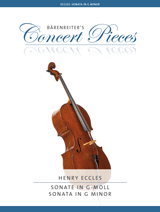
Sonata in G minor
Artikelnummer
BA10699
Kategori
Piano och instrument
Besättning
Cello och piano
Kompositör
Eccles Henry
Redaktör
Sassmannshaus Christoph
225 kr
- Well-known and effective piece
- A “must” for young cellists
- Easy piano arrangement
Henry Eccles was a Baroque composer and a contemporary to Johann Sebastian Bach (1685–1750), George Frideric Handel (1685–1759) and Antonio Vivaldi (1678–1741). His Violin Sonata in G minor was first published in 1720 for violin and figured bass and was later transcribed for cello and double bass.
This sonata is written in baroque sonata form, consisting of a slow introduction followed by three dance movements. The dance movements are based on court dances from the period. Students can listen to “Courante”, “Sarabande”, and “Gigue” movements from any of the 6 Unaccompanied Bach Cello Suites and compare them to the corresponding movements in the “Eccles Sonata”.
This sonata is an important stepping stone to more advanced techniques. It requires brush stroke and martelé with string crossings. The work also requires shifting into thumb position. These techniques will prepare the student to advance to more challenging works such as Saint-Saëns “Allegro appassionato” and the cello sonata repertoire.
- A “must” for young cellists
- Easy piano arrangement
Henry Eccles was a Baroque composer and a contemporary to Johann Sebastian Bach (1685–1750), George Frideric Handel (1685–1759) and Antonio Vivaldi (1678–1741). His Violin Sonata in G minor was first published in 1720 for violin and figured bass and was later transcribed for cello and double bass.
This sonata is written in baroque sonata form, consisting of a slow introduction followed by three dance movements. The dance movements are based on court dances from the period. Students can listen to “Courante”, “Sarabande”, and “Gigue” movements from any of the 6 Unaccompanied Bach Cello Suites and compare them to the corresponding movements in the “Eccles Sonata”.
This sonata is an important stepping stone to more advanced techniques. It requires brush stroke and martelé with string crossings. The work also requires shifting into thumb position. These techniques will prepare the student to advance to more challenging works such as Saint-Saëns “Allegro appassionato” and the cello sonata repertoire.
